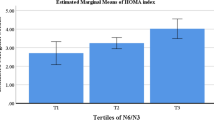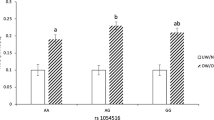Abstract
Context:
Fat-rich diets are involved in many disorders such as obesity and type 2 diabetes (T2D). The Pro12Ala variant of peroxisome proliferator-activated receptor-γ (PPARγ) is known to modulate body mass index (BMI) and T2D risk.
Objective:
Our aim was to study the interaction effect between PPARγ gene (PPARG) polymorphisms Pro12Ala and 1431C>T and fat intake on incident T2D and BMI in a 9-year prospective cohort drawn from the French general population, the D.E.S.I.R. (Data from an Epidemiological Study on the Insulin Resistance Syndrome) study (n=4676).
Methods:
Nutritional intake was assessed by a food frequency self-questionnaire completed by each participant. Statistical analyses included logistic regression, analysis of covariance and haplotype analysis, with adjustment for confounding variables.
Results:
A high fat consumption (the third sex-specific tertile of fat intake, as a percentage of energy intake) was associated with an increased T2D risk among ProPro and CC homozygotes (Pinteraction=0.05, odds ratio (OR) (95% confidence interval (95% CI))=1.73 (1.19–2.52) P=0.004 and OR=1.85 (1.27–2.71) P=0.001, respectively) but not in Ala and T carriers. There was a significant interaction effect between Pro12Ala and 1431C>T on BMI (Pinteraction=0.004); Ala was associated with lower BMI in CC homozygotes and with higher BMI in T carriers while the opposite was found for ProPro. There was also an interaction effect between Pro12Ala and dietary fat intake on BMI (Pinteraction=0.02); AlaAla individuals had a higher BMI than Pro carriers among high fat consumers (27.1±1.0 versus 24.9±0.1 for AlaAla and Pro+, respectively). There was no interaction effect between the 1431C>T single-nucleotide polymorphism and fat intake on BMI.
Conclusion:
Our results indicate strong genetic and nutritional interaction effects on BMI and T2D risk at the PPARG locus in a general population.
This is a preview of subscription content, access via your institution
Access options
Subscribe to this journal
Receive 12 print issues and online access
$259.00 per year
only $21.58 per issue
Buy this article
- Purchase on Springer Link
- Instant access to full article PDF
Prices may be subject to local taxes which are calculated during checkout



Similar content being viewed by others
References
Andreasen CH, Andersen G . Gene-environment interactions and obesity—further aspects of genomewide association studies. Nutrition 2009; 25: 998–1003.
Anghel SI, Wahli W . Fat poetry: a kingdom for PPAR gamma. Cell Res 2007; 17: 486–511.
Fajas L, Auboeuf D, Raspe E, Schoonjans K, Lefebvre AM, Saladin R et al. The organization, promoter analysis, and expression of the human PPARgamma gene. J Biol Chem 1997; 272: 18779–18789.
Mueller E, Drori S, Aiyer A, Yie J, Sarraf P, Chen H et al. Genetic analysis of adipogenesis through peroxisome proliferator-activated receptor gamma isoforms. J Biol Chem 2002; 277: 41925–41930.
Yen CJ, Beamer BA, Negri C, Silver K, Brown KA, Yarnall DP et al. Molecular scanning of the human peroxisome proliferator activated receptor gamma (hPPAR gamma) gene in diabetic Caucasians: identification of a Pro12Ala PPAR gamma 2 missense mutation. Biochem Biophys Res Commun 1997; 241: 270–274.
Jaziri R, Lobbens S, Aubert R, Pean F, Lahmidi S, Vaxillaire M et al. The PPARG Pro12Ala polymorphism is associated with a decreased risk of developing hyperglycemia over 6 years and combines with the effect of the APM1 G-11391A single nucleotide polymorphism: the Data from an Epidemiological Study on the Insulin Resistance Syndrome (DESIR) study. Diabetes 2006; 55: 1157–1162.
Masugi J, Tamori Y, Mori H, Koike T, Kasuga M . Inhibitory effect of a proline-to-alanine substitution at codon 12 of peroxisome proliferator-activated receptor-gamma 2 on thiazolidinedione-induced adipogenesis. Biochem Biophys Res Commun 2000; 268: 178–182.
Saxena R, Voight BF, Lyssenko V, Burtt NP, de Bakker PI, Chen H et al. Genome-wide association analysis identifies loci for type 2 diabetes and triglyceride levels. Science 2007; 316: 1331–1336.
Ludovico O, Pellegrini F, Di Paola R, Minenna A, Mastroianno S, Cardellini M et al. Heterogeneous effect of peroxisome proliferator-activated receptor gamma2 Ala12 variant on type 2 diabetes risk. Obesity (Silver Spring) 2007; 15: 1076–1081.
Lohmueller KE, Pearce CL, Pike M, Lander ES, Hirschhorn JN . Meta-analysis of genetic association studies supports a contribution of common variants to susceptibility to common disease. Nat Genet 2003; 33: 177–182.
Memisoglu A, Hu FB, Hankinson SE, Liu S, Meigs JB, Altshuler DM et al. Prospective study of the association between the proline to alanine codon 12 polymorphism in the PPARgamma gene and type 2 diabetes. Diabetes Care 2003; 26: 2915–2917.
Deeb SS, Fajas L, Nemoto M, Pihlajamaki J, Mykkanen L, Kuusisto J et al. A Pro12Ala substitution in PPARgamma2 associated with decreased receptor activity, lower body mass index and improved insulin sensitivity. Nat Genet 1998; 20: 284–287.
Meirhaeghe A, Fajas L, Helbecque N, Cottel D, Auwerx J, Deeb SS et al. Impact of the peroxisome proliferator activated receptor gamma2 Pro12Ala polymorphism on adiposity, lipids and non-insulin-dependent diabetes mellitus. Int J Obes Relat Metab Disord 2000; 24: 195–199.
Tonjes A, Scholz M, Loeffler M, Stumvoll M . Association of Pro12Ala polymorphism in peroxisome proliferator-activated receptor gamma with pre-diabetic phenotypes: meta-analysis of 57 studies on nondiabetic individuals. Diabetes Care 2006; 29: 2489–2497.
Valve R, Sivenius K, Miettinen R, Pihlajamaki J, Rissanen A, Deeb SS et al. Two polymorphisms in the peroxisome proliferator-activated receptor-gamma gene are associated with severe overweight among obese women. J Clin Endocrinol Metab 1999; 84: 3708–3712.
Ek J, Urhammer SA, Sorensen TI, Andersen T, Auwerx J, Pedersen O . Homozygosity of the Pro12Ala variant of the peroxisome proliferation-activated receptor-gamma2 (PPAR-gamma2): divergent modulating effects on body mass index in obese and lean Caucasian men. Diabetologia 1999; 42: 892–895.
Beamer BA, Yen CJ, Andersen RE, Muller D, Elahi D, Cheskin LJ et al. Association of the Pro12Ala variant in the peroxisome proliferator-activated receptor-gamma2 gene with obesity in two Caucasian populations. Diabetes 1998; 47: 1806–1808.
Masud S, Ye S . Effect of the peroxisome proliferator activated receptor-gamma gene Pro12Ala variant on body mass index: a meta-analysis. J Med Genet 2003; 40: 773–780.
Doney A, Fischer B, Frew D, Cumming A, Flavell DM, World M et al. Haplotype analysis of the PPARgamma Pro12Ala and C1431T variants reveals opposing associations with body weight. BMC Genet 2002; 3: 21.
Doney AS, Fischer B, Cecil JE, Boylan K, McGuigan FE, Ralston SH et al. Association of the Pro12Ala and C1431T variants of PPARG and their haplotypes with susceptibility to Type 2 diabetes. Diabetologia 2004; 47: 555–558.
Wei Q, Jacobs Jr DR, Schreiner PJ, Siscovick DS, Steffes MW, Fornage M . Patterns of association between PPARgamma genetic variation and indices of adiposity and insulin action in African-Americans and whites: the CARDIA Study. J Mol Med 2006; 84: 955–965.
Memisoglu A, Hu FB, Hankinson SE, Manson JE, De Vivo I, Willett WC et al. Interaction between a peroxisome proliferator-activated receptor gamma gene polymorphism and dietary fat intake in relation to body mass. Hum Mol Genet 2003; 12: 2923–2929.
Luan J, Browne PO, Harding AH, Halsall DJ, O’Rahilly S, Chatterjee VK et al. Evidence for gene-nutrient interaction at the PPARgamma locus. Diabetes 2001; 50: 686–689.
Vaccaro O, Lapice E, Monticelli A, Giacchetti M, Castaldo I, Galasso R et al. Pro12Ala polymorphism of the PPARgamma2 locus modulates the relationship between energy intake and body weight in type 2 diabetic patients. Diabetes Care 2007; 30: 1156–1161.
Heikkinen S, Argmann C, Feige JN, Koutnikova H, Champy MF, Dali-Youcef N et al. The Pro12Ala PPARgamma2 variant determines metabolism at the gene-environment interface. Cell Metab 2009; 9: 88–98.
Robitaille J, Despres JP, Perusse L, Vohl MC . The PPAR-gamma P12A polymorphism modulates the relationship between dietary fat intake and components of the metabolic syndrome: results from the Quebec Family Study. Clin Genet 2003; 63: 109–116.
Balkau B . An epidemiologic survey from a network of French Health Examination Centres (D.E.S.I.R.): epidemiologic data on the insulin resistance syndrome. Rev Epidemiol Sante Publique 1996; 44: 373–375.
The Expert Committee on the Diagnosis and Classification of Diabetes Mellitus. Report of the Expert Committee on the Diagnosis and Classification of Diabetes Mellitus. Diabetes Care 1997; 20: 1183–1197.
Lasfargues G, Vol S, Le Clesiau H, Bedouet M, Hagel L, Constans T et al. Validity of a short self-administered dietary questionnaire compared with a dietetic interview. Presse Med 1990; 19: 953–957.
Tregouet DA, Garelle V . A new JAVA interface implementation of THESIAS: testing haplotype effects in association studies. Bioinformatics 2007; 23: 1038–1039.
Vaxillaire M, Veslot J, Dina C, Proenca C, Cauchi S, Charpentier G et al. Impact of common type 2 diabetes risk polymorphisms in the DESIR prospective study. Diabetes 2008; 57: 244–254.
Acknowledgements
The D.E.S.I.R. study has been supported by INSERM contracts with CNAMTS, Lilly, Novartis Pharma and Sanofi-Aventis; by INSERM (Réseaux en Santé Publique, Interactions entre les déterminants de la santé, Cohortes Santé TGIR 2008), the Association Diabète Risque Vasculaire, the Fédération Française de Cardiologie, La Fondation de France, ALFEDIAM, CNIEL, ONIVINS, Société Francophone du Diabète, Ardix Medical, Bayer Diagnostics, Becton Dickinson, Cardionics, Merck Santé, Novo Nordisk, Pierre Fabre, Roche, Topcon.
The D.E.S.I.R. Study Group: INSERM CESP U1018: B Balkau, P Ducimetière and E Eschwège; INSERM U367: F Alhenc-Gelas; CHU D’Angers: Y Gallois and A Girault; Bichat Hospital: F Fumeron and M Marre; CHU de Rennes: F Bonnet; CNRS UMR8090, Lille: P Froguel; Centres d’Examens de Santé: Alençon, Angers, Blois, Caen, Chartres, Chateauroux, Cholet, Le Mans, Orléans and Tours; Institute de Recherche Médecine Générale: J Cogneau; General practitioners of the region; Institute inter-Regional pour la Santé: C Born, E Caces, M Cailleau, JG Moreau, O Lantieri, F Rakotozafy, J Tichet and S Vol.
Author information
Authors and Affiliations
Consortia
Corresponding author
Ethics declarations
Competing interests
The authors declare no conflict of interest.
Rights and permissions
About this article
Cite this article
Lamri, A., Abi Khalil, C., Jaziri, R. et al. Dietary fat intake and polymorphisms at the PPARG locus modulate BMI and type 2 diabetes risk in the D.E.S.I.R. prospective study. Int J Obes 36, 218–224 (2012). https://doi.org/10.1038/ijo.2011.91
Received:
Revised:
Accepted:
Published:
Issue Date:
DOI: https://doi.org/10.1038/ijo.2011.91
Keywords
This article is cited by
-
Dietary and genetic risk scores and incidence of type 2 diabetes
Genes & Nutrition (2018)
-
Reversing the tide — diagnosis and prevention of T2DM in populations of African descent
Nature Reviews Endocrinology (2018)
-
Phenotype and genotype predictors of BMI variability among European adults
Nutrition & Diabetes (2018)
-
The heritable basis of gene–environment interactions in cardiometabolic traits
Diabetologia (2017)
-
The C1431T polymorphism of peroxisome proliferator activated receptor γ (PPARγ) is associated with low risk of diabetes in a Pakistani cohort
Diabetology & Metabolic Syndrome (2016)



